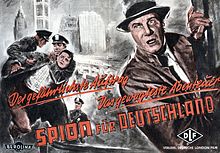Spy for Germany
Spy for Germany is a German feature film from 1956 . Directed by Werner Klingler , Martin Held plays the title role of the German World War II agent Erich Gimpel .
action
Second World War 1944, German Empire . Colonel Sommerfeld of the Abwehr has a delicate assignment for the spy Erich Gimpel. Together with the American defector Billy Cole (in reality: William Colepaugh) he is to be dropped off by a German submarine on the US coast. Both should then make their way to New York to get in touch with leading representatives of the Manhattan Project in order to find out how far the Americans have come with their nuclear weapons research. Gimpel will be endowed with $ 60,000 in cash and approximately $ 100,000 in diamonds. But from the outset, things went very badly. Gimpel is overwhelmed, his comrade-in-arms Cole uses the next best opportunity to defeat again, this time to his own compatriots, to whom he reports about Gimpel and his assignment.
From now on, Gimpel is mercilessly harassed by American FBI agents, led by Roger Bentley and Jim Newman. For a short time he found refuge with the American Joan Kenneth, for whom he soon developed feelings. But Agent 146, his code name, has no real chance at any time. The Americans are hot on his heels, and eventually he falls into their clutches. Gimpel almost seems to be happy that the enemy's chase on him is failing his mission, which was pointless from the start. Even under President Franklin D. Roosevelt , Erich Gimpel was sentenced to death as an enemy spy ; his execution is prevented only by Roosevelt's death. His successor Harry S. Truman reduced the sentence to life . Gimpel is released after eleven years. Joan waited so long for him.
Production notes
The external shoots for Spion für Deutschland took place in New York City and Boston , the studio recordings were made in Berlin . The premiere was on December 4, 1956. On June 4, 1965, Spion für Deutschland was shown for the first time on television when it was broadcast on ZDF .
The film is based on actual circumstances around the less successful German US spy Erich Gimpel and his attempts to obtain information about the American atomic and hydrogen bomb program.
Alf Teichs was head of production. The buildings come from Hanns H. Kuhnert , Paul Markwitz and Peter Schlewski, the costumes were designed by Walter Salemann. Ralph Lothar assisted director Klingler and also took on a small supporting role. Heinz Willeg was one of two production managers.
The German photographer and cameraman Heinz von Jaworsky , who has been living in the USA for some time, was responsible for the American exterior shots. For the German Martin Kosleck , who emigrated to Hollywood in 1931 , Spion für Deutschland was the first film in a quarter of a century in which he could speak German again and at the same time his only feature film in the 1950s. For director Klingler, who had not directed a film since 1948 and had lived in the USA since then, this film material set on US soil was an ideal calling card for entry into German film events.
criticism
“The German spy Erich Gimpel, who was sentenced to death in America towards the end of the Second World War and who later returned home pardoned, has won a series of magazines from the horror endured. The script by the author Herbert Reinecker ('Canaris') on the one hand clings so closely to Gimpel's report that there is no real cinematic tension, on the other hand it switches with the facts freely enough to damage the probability. In this half-successful film, Martin Held as Gimpel proves that he can transform himself completely for any role without the magic of a mask, an ability that lifts him above almost all German film celebrities. "
"In spite of a few unbelievable things, the whole thing is exciting."
Paimann's film lists summed up: “Despite its semi-documentary character, it is logically processed in a sophisticated increase; with selected, but pronounced German cast of the American roles. "
Individual evidence
- ↑ Spy for Germany. In: Lexicon of International Films . Film service , accessed March 2, 2017 .
- ↑ Spy for Germany in Paimann's film lists
Web links
- Spy for Germany in the Internet Movie Database (English)
- Spy for Germany at filmportal.de

